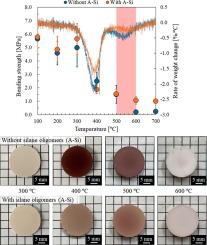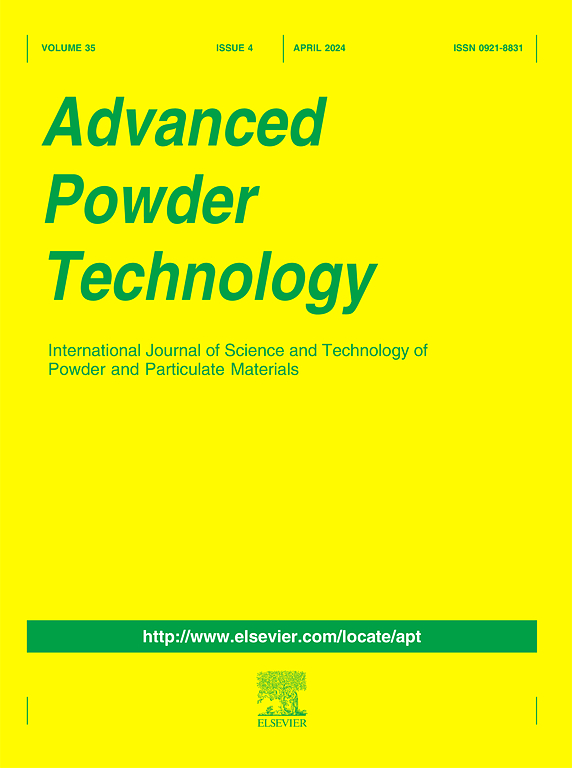Crack suppression during debinding of photocured green bodies comprising interparticle polymer cross-links with silane oligomers
IF 4.2
2区 工程技术
Q2 ENGINEERING, CHEMICAL
引用次数: 0
Abstract
Interparticle photo-cross-linkable suspension, which is a suspension photocurable via polymer cross-linking reaction among ceramic particles stabilized by a reactive polymer dispersant, is one of the promising materials to realize three-dimensional structuring of ceramic components through hybridized approaches of photocuring and green machining. Reactive silane oligomers functionalized with acryloyl groups (A-Si) have been reported to copolymerize in the interparticle cross-links, effectively inhibiting cracking during rapid debinding of green bodies. However, the role of A-Si in crack suppression during debinding remains poorly understood. Herein, the impact of A-Si copolymerization on the crack prevention of photo-cured bodies during rapid debinding is systematically investigated by high-temperature in situ three-point bending tests of photo-cured bodies and characterization of the microstructures and chemical structures of interparticle photo-crosslinks. Co-polymerization of A-Si in the cross-links improved the three-point bending strength of debinded bodies at 500–600 °C, where the green bodies without A-Si cracked. The prevention of cracking during debinding in samples containing A-Si was attributed to the generation of inorganic siloxane cross-links. This study provides a perspective on crafting machinable photo-cured green compacts, enabling their processing through time- and cost-effective rapid debinding methods.

用硅烷低聚物进行颗粒间聚合物交联的光固化绿色体在脱胶过程中抑制裂纹的产生
颗粒间光交联悬浮液是一种通过反应性聚合物分散剂稳定的陶瓷颗粒间的聚合物交联反应实现光固化的悬浮液,是通过光固化和绿色加工的混合方法实现陶瓷部件三维结构化的有前途的材料之一。据报道,丙烯酰基官能化的反应性硅烷低聚物(A-Si)可在颗粒间的交联中发生共聚,从而有效抑制生坯快速脱模过程中的开裂。然而,人们对 A-Si 在排胶过程中抑制裂纹的作用仍知之甚少。在此,通过对光固化体进行高温原位三点弯曲试验,并对粒子间光交联的微观结构和化学结构进行表征,系统地研究了 A-Si 共聚对光固化体在快速脱胶过程中防止开裂的影响。交联中的 A-Si 共聚提高了脱胶体在 500-600 °C 下的三点弯曲强度,而不含 A-Si 的绿色脱胶体则会开裂。含有 A-Si 的样品在排胶过程中防止了开裂,这要归功于无机硅氧烷交联的产生。这项研究为制作可加工的光固化绿色密实材料提供了一个视角,使其能够通过省时、经济的快速排胶方法进行加工。
本文章由计算机程序翻译,如有差异,请以英文原文为准。
求助全文
约1分钟内获得全文
求助全文
来源期刊

Advanced Powder Technology
工程技术-工程:化工
CiteScore
9.50
自引率
7.70%
发文量
424
审稿时长
55 days
期刊介绍:
The aim of Advanced Powder Technology is to meet the demand for an international journal that integrates all aspects of science and technology research on powder and particulate materials. The journal fulfills this purpose by publishing original research papers, rapid communications, reviews, and translated articles by prominent researchers worldwide.
The editorial work of Advanced Powder Technology, which was founded as the International Journal of the Society of Powder Technology, Japan, is now shared by distinguished board members, who operate in a unique framework designed to respond to the increasing global demand for articles on not only powder and particles, but also on various materials produced from them.
Advanced Powder Technology covers various areas, but a discussion of powder and particles is required in articles. Topics include: Production of powder and particulate materials in gases and liquids(nanoparticles, fine ceramics, pharmaceuticals, novel functional materials, etc.); Aerosol and colloidal processing; Powder and particle characterization; Dynamics and phenomena; Calculation and simulation (CFD, DEM, Monte Carlo method, population balance, etc.); Measurement and control of powder processes; Particle modification; Comminution; Powder handling and operations (storage, transport, granulation, separation, fluidization, etc.)
 求助内容:
求助内容: 应助结果提醒方式:
应助结果提醒方式:


